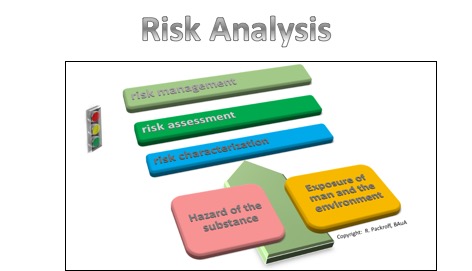Risk analysis is broadly defined to include risk assessment , risk characterization, risk communication, risk management, and policy relating to risk, in the context of risks of concern to individuals, to public- and private-sector organizations, and to society at a local, regional, national, or global level [1].
In general, the term “risk” denotes the potential loss of something of value, e.g. health or an intact environment or simply your purse. A risk exists only if hazard and exposure occur together.
A complete risk analysis of a new material is a multi-step process.
Important parts of a risk analysis are ‘risk assessment’ and ‘risk management‘. Risk management is the regulatory and decision making part. Risk assessment is supposed to be carried out by independent experts and should be based on scientific evidence. Risk characterization, -assessment and -management build upon each other in a consecutive hierarchy. After all these steps at the end risk communication is crucial to implement the knowledge at workplaces or on consumer-level.

Schematic sketch of a risk analysis © BAuA/ R. Packroff
Tools for risk analysis
Within the process of risk analysis there are 4 levels at which different decisions have to be taken. The first level is to gain knowledge about a possible biological activity of a given substance or nanomaterial (hazard characterization) and in parallel to check carefully if humans or the environment are exposed to noteworthy concentrations (exposure analysis). If a biological effect could be measured and a certain exposure can be assumed, a potential risk can be characterized and this is the second level of this process. This step contains a first estimation about the probability someone is exposed to concentrations of the considered material which may induce an adverse effect.
On the third level based on the data produced so far the assessment of a possible risk is in the center of attention. In short the ranges of concentrations at workplaces, in the environment or during use of the product will be determined to estimate the possibility exposed people or environmental organisms may be affected negatively. This step is explained in more detail in the chapter Risk Assessment of Nanomaterials.
If the risk assessment process results in reason of concern the risk has to be managed. This means measures have to be taken to mitigate or prevent this risk and it should be communicated to the exposed group of people. This last step in risk analysis is explained separately in the chapter Risk Management of Nanomaterials.
Literature
- Society for Risk Analysis (http://www.sra.org) in Englisch
 >
>